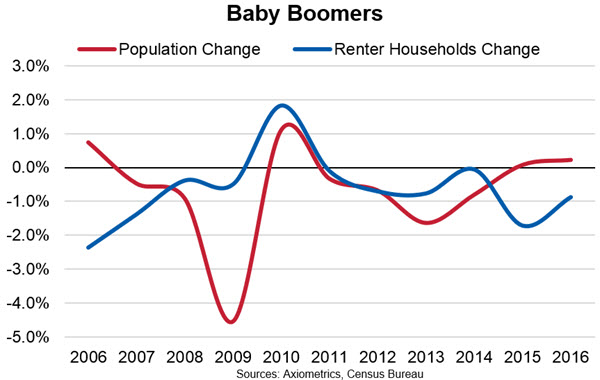This article was originally posted by Chuck Ehmann discusses how baby boomers in apartments have evolved in recent years.
Much has been written and discussed about the increasing numbers of baby boomers and empty nesters who have forsaken homeownership and turned to renting as a lifestyle choice. The evidence for this discussion has been anecdotal, for the most part, as few solid numbers quantifying this trend of boomers in apartments have surfaced.
Another problem with measuring the existence of this trend is that researchers tend to utilize the age cohort reported by the U.S. Census Bureau that most closely spans the age of the baby boomers today – ages 55-74. The generally-accepted birth year range for baby boomers is 1946-1964, which would make boomers 52-70 years old in 2016.
The following chart illustrates the annual growth trend for the 55- to 74-year-old cohort for population and renter households. Over the past 10 years, the population of the 55-74 group has increased an average of 3.2% annually, and the number of renter households for this group increased 4.8% annually. That would indicate that boomer renters are increasing faster than their population. Or would it?

The problem is that today’s boomers were not 55-74 for the past 10 years. They were 45-64 years old in 2006 (utilizing the householder age cohorts).
The following graphic illustrates the movement of the millennial, Gen-X, and baby-boomer generations through the different age cohorts from 2005-2016. Although the Census-by-age data only runs through 2014, estimates for 2015-2016 were made based on historical patterns and trends.

Theoretically, the population of baby boomers should not change a great deal over time, save for the inclusion of migration and exclusion of deaths and emigration. The baby-boomer population has fallen from 74.0 million in 2005 to 68.8 million in 2016. The annual change in the boomer population has averaged -0.7% per year — slightly decreasing, as you would expect.

At the same time, the number of boomer renter households (adjusted for age) has decreased by an annual average of -0.6%, dropping from 10.1 million in 2005 to 9.4 million today. This goes against the accepted premise and the measurement of the 55-74 year-old cohort. The only year in which baby-boomer renter households increased was 2010, at the height of the foreclosure crisis following the housing bubble and Great Recession (see chart above).
While this is a somewhat crude measure of the change in baby boomer renter households, it does indicate that measuring the perceived increasing trend in boomer renters is more complicated when the quantifiable data available are limited. Based on Axiometrics’ discussions with our apartment developer, management and owner clients, we believe that there is an increasing trend toward renters-by-choice or “lifestyle” renters among the baby boomer population, especially in urban core and urban infill locations.
Although difficult to see on a national level, further research on a metropolitan or local level may reveal this phenomenon. There are undoubtedly a number of baby boomers choosing to rent apartments in urban locations that are close to shopping, restaurants, culture, transit and employment, and offer the luxury finishes and amenities they can afford. Measuring this trend is the challenge.
Other findings of this analysis include:
- With the Census Bureau’s minimum age of 15 for household headship, the millennial’s count of renter households begins at a little less than 4.5 million in 2005, but that grows to more than 15.3 million by 2016, when the entire age range for this generation is counted. That represents an annual average increase of 12.1%, about as expected for this prime renter age group.
- Gen-X renter households were essentially flat, decreasing -0.2% annually from 17.3 million to 17.0 million. Over the past 10 years, Gen-Xers have been transitioning from their prime renter years toward the age that homeownership is more appealing. But their lower homeownership rate indicates they are still having difficulties with or trepidations about buying a home (although their annual average increase in owner households was 1.6%).
This article was originally posted by AXIOMetrics Inc. and can be found HERE.



